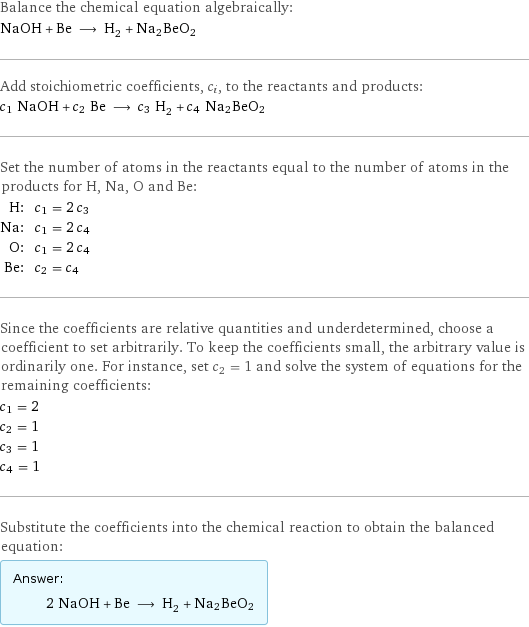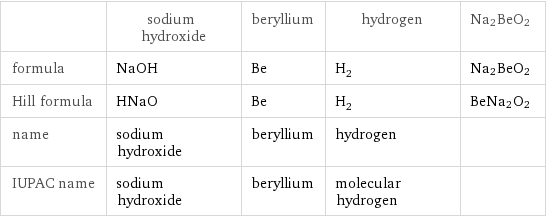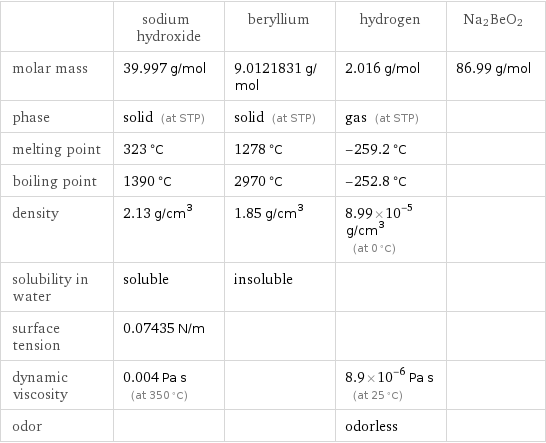Input interpretation

NaOH sodium hydroxide + Be beryllium ⟶ H_2 hydrogen + Na2BeO2
Balanced equation

Balance the chemical equation algebraically: NaOH + Be ⟶ H_2 + Na2BeO2 Add stoichiometric coefficients, c_i, to the reactants and products: c_1 NaOH + c_2 Be ⟶ c_3 H_2 + c_4 Na2BeO2 Set the number of atoms in the reactants equal to the number of atoms in the products for H, Na, O and Be: H: | c_1 = 2 c_3 Na: | c_1 = 2 c_4 O: | c_1 = 2 c_4 Be: | c_2 = c_4 Since the coefficients are relative quantities and underdetermined, choose a coefficient to set arbitrarily. To keep the coefficients small, the arbitrary value is ordinarily one. For instance, set c_2 = 1 and solve the system of equations for the remaining coefficients: c_1 = 2 c_2 = 1 c_3 = 1 c_4 = 1 Substitute the coefficients into the chemical reaction to obtain the balanced equation: Answer: | | 2 NaOH + Be ⟶ H_2 + Na2BeO2
Structures

+ ⟶ + Na2BeO2
Names

sodium hydroxide + beryllium ⟶ hydrogen + Na2BeO2
Equilibrium constant
![Construct the equilibrium constant, K, expression for: NaOH + Be ⟶ H_2 + Na2BeO2 Plan: • Balance the chemical equation. • Determine the stoichiometric numbers. • Assemble the activity expression for each chemical species. • Use the activity expressions to build the equilibrium constant expression. Write the balanced chemical equation: 2 NaOH + Be ⟶ H_2 + Na2BeO2 Assign stoichiometric numbers, ν_i, using the stoichiometric coefficients, c_i, from the balanced chemical equation in the following manner: ν_i = -c_i for reactants and ν_i = c_i for products: chemical species | c_i | ν_i NaOH | 2 | -2 Be | 1 | -1 H_2 | 1 | 1 Na2BeO2 | 1 | 1 Assemble the activity expressions accounting for the state of matter and ν_i: chemical species | c_i | ν_i | activity expression NaOH | 2 | -2 | ([NaOH])^(-2) Be | 1 | -1 | ([Be])^(-1) H_2 | 1 | 1 | [H2] Na2BeO2 | 1 | 1 | [Na2BeO2] The equilibrium constant symbol in the concentration basis is: K_c Mulitply the activity expressions to arrive at the K_c expression: Answer: | | K_c = ([NaOH])^(-2) ([Be])^(-1) [H2] [Na2BeO2] = ([H2] [Na2BeO2])/(([NaOH])^2 [Be])](../image_source/4c09358be1d6287166e28b0b5962602d.png)
Construct the equilibrium constant, K, expression for: NaOH + Be ⟶ H_2 + Na2BeO2 Plan: • Balance the chemical equation. • Determine the stoichiometric numbers. • Assemble the activity expression for each chemical species. • Use the activity expressions to build the equilibrium constant expression. Write the balanced chemical equation: 2 NaOH + Be ⟶ H_2 + Na2BeO2 Assign stoichiometric numbers, ν_i, using the stoichiometric coefficients, c_i, from the balanced chemical equation in the following manner: ν_i = -c_i for reactants and ν_i = c_i for products: chemical species | c_i | ν_i NaOH | 2 | -2 Be | 1 | -1 H_2 | 1 | 1 Na2BeO2 | 1 | 1 Assemble the activity expressions accounting for the state of matter and ν_i: chemical species | c_i | ν_i | activity expression NaOH | 2 | -2 | ([NaOH])^(-2) Be | 1 | -1 | ([Be])^(-1) H_2 | 1 | 1 | [H2] Na2BeO2 | 1 | 1 | [Na2BeO2] The equilibrium constant symbol in the concentration basis is: K_c Mulitply the activity expressions to arrive at the K_c expression: Answer: | | K_c = ([NaOH])^(-2) ([Be])^(-1) [H2] [Na2BeO2] = ([H2] [Na2BeO2])/(([NaOH])^2 [Be])
Rate of reaction
![Construct the rate of reaction expression for: NaOH + Be ⟶ H_2 + Na2BeO2 Plan: • Balance the chemical equation. • Determine the stoichiometric numbers. • Assemble the rate term for each chemical species. • Write the rate of reaction expression. Write the balanced chemical equation: 2 NaOH + Be ⟶ H_2 + Na2BeO2 Assign stoichiometric numbers, ν_i, using the stoichiometric coefficients, c_i, from the balanced chemical equation in the following manner: ν_i = -c_i for reactants and ν_i = c_i for products: chemical species | c_i | ν_i NaOH | 2 | -2 Be | 1 | -1 H_2 | 1 | 1 Na2BeO2 | 1 | 1 The rate term for each chemical species, B_i, is 1/ν_i(Δ[B_i])/(Δt) where [B_i] is the amount concentration and t is time: chemical species | c_i | ν_i | rate term NaOH | 2 | -2 | -1/2 (Δ[NaOH])/(Δt) Be | 1 | -1 | -(Δ[Be])/(Δt) H_2 | 1 | 1 | (Δ[H2])/(Δt) Na2BeO2 | 1 | 1 | (Δ[Na2BeO2])/(Δt) (for infinitesimal rate of change, replace Δ with d) Set the rate terms equal to each other to arrive at the rate expression: Answer: | | rate = -1/2 (Δ[NaOH])/(Δt) = -(Δ[Be])/(Δt) = (Δ[H2])/(Δt) = (Δ[Na2BeO2])/(Δt) (assuming constant volume and no accumulation of intermediates or side products)](../image_source/35b764df3e78686fc50a7f805f072145.png)
Construct the rate of reaction expression for: NaOH + Be ⟶ H_2 + Na2BeO2 Plan: • Balance the chemical equation. • Determine the stoichiometric numbers. • Assemble the rate term for each chemical species. • Write the rate of reaction expression. Write the balanced chemical equation: 2 NaOH + Be ⟶ H_2 + Na2BeO2 Assign stoichiometric numbers, ν_i, using the stoichiometric coefficients, c_i, from the balanced chemical equation in the following manner: ν_i = -c_i for reactants and ν_i = c_i for products: chemical species | c_i | ν_i NaOH | 2 | -2 Be | 1 | -1 H_2 | 1 | 1 Na2BeO2 | 1 | 1 The rate term for each chemical species, B_i, is 1/ν_i(Δ[B_i])/(Δt) where [B_i] is the amount concentration and t is time: chemical species | c_i | ν_i | rate term NaOH | 2 | -2 | -1/2 (Δ[NaOH])/(Δt) Be | 1 | -1 | -(Δ[Be])/(Δt) H_2 | 1 | 1 | (Δ[H2])/(Δt) Na2BeO2 | 1 | 1 | (Δ[Na2BeO2])/(Δt) (for infinitesimal rate of change, replace Δ with d) Set the rate terms equal to each other to arrive at the rate expression: Answer: | | rate = -1/2 (Δ[NaOH])/(Δt) = -(Δ[Be])/(Δt) = (Δ[H2])/(Δt) = (Δ[Na2BeO2])/(Δt) (assuming constant volume and no accumulation of intermediates or side products)
Chemical names and formulas

| sodium hydroxide | beryllium | hydrogen | Na2BeO2 formula | NaOH | Be | H_2 | Na2BeO2 Hill formula | HNaO | Be | H_2 | BeNa2O2 name | sodium hydroxide | beryllium | hydrogen | IUPAC name | sodium hydroxide | beryllium | molecular hydrogen |
Substance properties

| sodium hydroxide | beryllium | hydrogen | Na2BeO2 molar mass | 39.997 g/mol | 9.0121831 g/mol | 2.016 g/mol | 86.99 g/mol phase | solid (at STP) | solid (at STP) | gas (at STP) | melting point | 323 °C | 1278 °C | -259.2 °C | boiling point | 1390 °C | 2970 °C | -252.8 °C | density | 2.13 g/cm^3 | 1.85 g/cm^3 | 8.99×10^-5 g/cm^3 (at 0 °C) | solubility in water | soluble | insoluble | | surface tension | 0.07435 N/m | | | dynamic viscosity | 0.004 Pa s (at 350 °C) | | 8.9×10^-6 Pa s (at 25 °C) | odor | | | odorless |
Units
